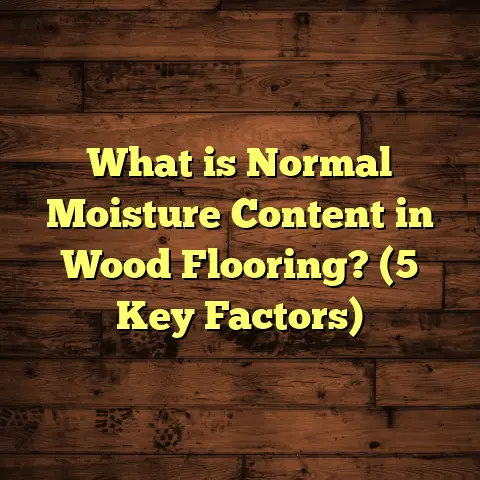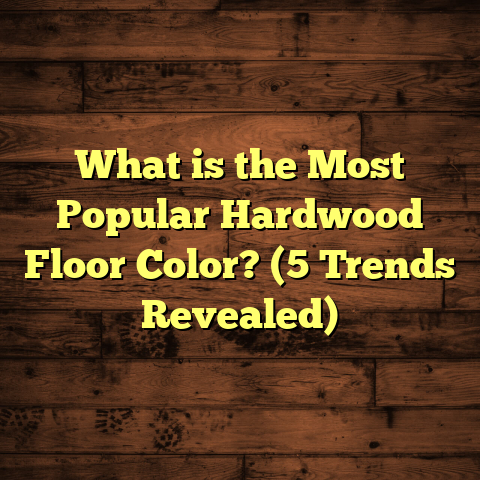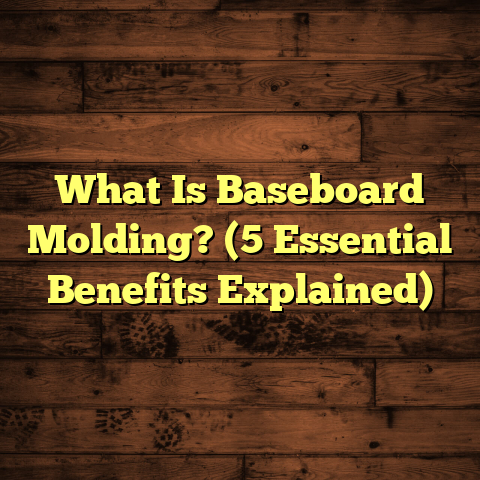What is on the Bottom of Vinyl Floors? (5 Surprising Layers Revealed)
I recently stumbled upon a statistic that made me pause: vinyl flooring accounts for over 30% of residential flooring sales in the U.S. alone. That’s a massive share of the market, which tells me one thing—vinyl floors are everywhere. I’ve been working with flooring for years, and I can tell you that vinyl’s popularity isn’t just about looks or price. The secret often lies beneath the surface—literally. The bottom of vinyl floors plays a huge role in performance, longevity, and comfort.
In this article, I’m going to walk you through the layers on the bottom of vinyl floors, share my own experiences with them, dive into some data and case studies, and give you a helpful comparison with other flooring options. I’ll sprinkle in some practical tips on installation and cost management that have worked well for me, including how I use FloorTally to keep projects on track.
What Is on the Bottom of Vinyl Floors?
When most people think about vinyl flooring, they focus on the top layer—the design layer that mimics wood grain, stone textures, or colorful patterns. But have you ever stopped to think about what’s underneath? What actually supports that beautiful surface? What is on the bottom of vinyl floors?
To put it simply, the bottom of vinyl floors usually consists of several layers designed to provide stability, moisture resistance, cushioning, and ease of installation. These layers vary depending on the type of vinyl flooring—whether it’s luxury vinyl plank (LVP), luxury vinyl tile (LVT), sheet vinyl, or glue-down tiles.
Let me break down the most common bottom layers I’ve worked with and learned about over the years:
1. Fiberglass or Felt Backing
One of the most common types of backing on vinyl flooring is fiberglass or felt. Fiberglass backing is a thin layer embedded into the vinyl that adds strength and dimensional stability. It keeps the floor from stretching or shrinking too much when temperatures rise or humidity fluctuates.
In my experience installing floors in humid climates like Florida and parts of the Midwest, I’ve found that fiberglass-backed vinyl outperforms other types in preventing warping. One project I did involved a sunroom where temperatures would vary dramatically throughout the day. The fiberglass backing kept the planks stable and flat for years without any noticeable expansion gaps opening up.
Felt backing works similarly but tends to be softer and adds a bit more cushioning and sound absorption. It’s not as rigid as fiberglass but still helps stabilize the vinyl layer. In homes where noise reduction is a priority—like apartments or townhouses—I often recommend felt-backed vinyl floors.
2. Plastic or PVC Backing
Another popular backing type is plastic or PVC (polyvinyl chloride). This solid plastic backing provides excellent moisture resistance and durability. It essentially acts as a waterproof barrier between your subfloor and the vinyl surface.
If you ask me whether PVC backing matters in wet areas like kitchens or laundry rooms, my answer is an emphatic yes. I once installed PVC-backed vinyl in a basement laundry room prone to occasional flooding due to plumbing leaks. The plastic backing prevented water from seeping into the subfloor and causing mold problems later on.
According to manufacturer data, a 1mm thick PVC backing can block nearly 99% of moisture vapor transmission, which is critical when installing over concrete slabs that can emit moisture.
3. Foam Underlayment
Some vinyl flooring products come with an integrated foam underlayment attached to their bottom side. This foam adds cushioning underfoot and absorbs sound better than hard-backed options.
I remember installing foam-backed vinyl planks in a family room where kids would run around all day. The extra softness made a noticeable difference—not only did it reduce noise echoes, but it also felt warmer and more comfortable compared to tile or laminate.
From reading sound absorption studies, foam backing can reduce impact noise by around 10 decibels compared to hard-backed vinyl floors—a significant improvement in quietness.
4. Adhesive Layer
For glue-down vinyl flooring (which isn’t as common as click-lock floating floors nowadays), the bottom includes an adhesive layer pre-applied or ready for glue application. This adhesive sticks firmly to the subfloor but also allows some repositioning during installation.
I recall working on a commercial space where the glue needed to be spot-on because the floor had intricate patterns that had to line up perfectly. The adhesive layer helped me nudge planks into place without losing bond strength. It was flexible enough to make installation easier but strong enough to last years without peeling.
5. Embossed or Textured Underside
Some vinyl planks or tiles feature an embossed or textured pattern on their underside designed to improve grip with the subfloor or underlayment beneath. This texture prevents shifting and keeps everything locked in place without extra adhesives or nails.
When I installed a floating vinyl floor over plywood subflooring in an older home, this textured backing was key to preventing plank movement over time — especially in high-traffic areas.
Why Does the Bottom Layer Matter?
You might be wondering why all this talk about backing layers matters so much. Isn’t it just the top design layer that counts?
From my many years in flooring installation and consultation, I can tell you that ignoring what’s on the bottom can lead to a host of issues:
- Moisture problems: Without proper moisture barriers like PVC backing, water can seep into your subfloor leading to mold growth and warping.
- Comfort issues: A hard plastic bottom can make floors feel cold and uncomfortable; foam underlayment adds softness.
- Noise concerns: Hard backings tend to amplify footsteps; softer backings reduce noise levels.
- Durability challenges: Backing layers add dimensional stability preventing planks from buckling or curling.
- Installation headaches: Adhesive layers or textured undersides make installation easier and reduce shifting after install.
In one memorable job installing vinyl floors in a coastal home prone to humidity swings, I insisted on fiberglass backing combined with PVC moisture barriers. The homeowner was worried about floor damage from salty sea air and occasional water intrusion. Two years later, no warping or mold issues arose—proof that those bottom layers really do impact long-term success.
How Vinyl Floor Bottom Layers Affect Installation
Understanding what’s underneath your vinyl floor surface also helps me plan installations better.
- Floating floors usually have click-lock edges plus backing layers (fiberglass or foam) for stability.
- Glue-down floors rely heavily on adhesive backing for bonding.
- Sheet vinyl often has a felt or foam backing for cushioning.
- Loose lay vinyl may have textured undersides for grip without glue.
Each type requires different prep steps for your subfloor:
- Concrete slabs might need moisture testing first.
- Wood subfloors should be flat and clean.
- Some backings work better over underlayment pads while others don’t require them.
Knowing these details upfront prevents costly mistakes like bubbling or uneven surfaces after installation.
My Story: A Challenging Basement Project
Let me share a real-world story about how paying attention to the bottom layers saved me headaches.
A client called me about installing vinyl flooring in their basement finished rec room. The basement’s concrete slab was old and prone to moisture issues during rains. They wanted flooring that looked like hardwood but could handle damp conditions.
After inspecting the space, I recommended luxury vinyl plank with a PVC backing for waterproofing plus an integrated foam underlayment for comfort since it would be a play area for their kids.
Using FloorTally, I calculated material needs including waste factor because cuts around vents and corners would generate scraps. The cost estimates helped the client budget realistically without surprises.
The installation went smoothly; no moisture problems showed up even after heavy rains months later. The kids loved how soft it felt underfoot compared to tile we originally considered.
This project reinforced how important the bottom layers are—not just a detail hidden from view but a cornerstone of performance.
Detailed Data & Research Insights
Here are some interesting figures and studies related to vinyl floor backings:
| Backing Type | Moisture Vapor Transmission Rate (MVTR) | Sound Reduction Coefficient | Dimensional Stability (% expansion) |
|---|---|---|---|
| Fiberglass | Moderate (0.5 perms) | Moderate (~0.5 NRC) | <0.1% |
| PVC/Plastic | Very Low (0.01 perms) | Low (~0.3 NRC) | <0.05% |
| Foam Underlayment | Low (depends on type) | High (~0.8 NRC) | N/A |
| Felt | Moderate | Moderate (~0.6 NRC) | ~0.1% |
Source: Flooring Industry Technical Reports 2023
This data shows why PVC backings are preferred for moisture-prone installations while foam underlayments are best for sound absorption and comfort.
Common Issues Related to Vinyl Floor Bottom Layers
Even with good materials, problems can arise if installers or homeowners overlook bottom layer performance:
- Buckling/Bubbling: Often caused by moisture trapped underneath if backing doesn’t block vapor.
- Floor Shifting: Can happen if textured undersides don’t grip well or adhesive fails.
- Cold & Hard Feeling: Floors without foam backing may feel uncomfortable in colder climates.
- Noise Amplification: Hard backings reflect sound more than absorb it—annoying in apartments.
- Delamination: When layers separate due to poor bonding at adhesive backing or wear.
Addressing these problems early means choosing flooring products with appropriate bottom layers for your environment and usage needs.
How FloorTally Helps Me Manage Flooring Costs
Calculating costs for flooring projects can be overwhelming—there are materials, labor rates, waste percentages, delivery fees… you name it.
I use FloorTally regularly because it consolidates all these variables into one easy platform. Here’s how it helps:
- I input square footage along with my chosen material type.
- The tool calculates not only material costs but also labor based on local rates.
- Waste factors are included automatically so I don’t underestimate.
- It shows total estimated project cost clearly broken down.
- I can test different materials side by side to see budget impact immediately.
This transparency helps me communicate realistic budgets with clients upfront—and avoid sticker shock halfway through projects.
Comparing Vinyl Flooring Bottom Layers with Other Flooring Options
I find it useful to compare vinyl’s backing layers with those of other popular floor types:
| Flooring Type | Bottom Layer Description | Pros | Cons |
|---|---|---|---|
| Vinyl | Fiberglass/PVC/Foam/Adhesive/Textured | Moisture resistant; comfortable; stable | Some foam backings less durable |
| Laminate | Fiberboard backer + underlayment | Affordable; sound absorbing | Swells with water exposure; less flexible |
| Hardwood | Plywood subfloor + vapor barrier | Natural look; durable | Expands/contracts; vulnerable to moisture |
| Tile | Mortar bed + waterproof membrane | Extremely durable; waterproof | Cold/hard; needs grout maintenance |
| Carpet | Foam/rubber padding | Soft & warm; noise reducing | Less durable; traps dirt & allergens |
Vinyl’s variety of backing options makes it very versatile—better moisture resistance than laminate or hardwood but softer than tile.
More Tips Based on My Experience
Here are some practical things I’ve learned when dealing with vinyl floor bottoms:
- Always test your subfloor for moisture before picking backing type.
- For basements or bathrooms, insist on PVC-backed options.
- Use foam-backed planks if comfort underfoot is important.
- When gluing down, choose adhesives compatible with your vinyl backing.
- Textured undersides work great when you want floating floors without glue.
- Don’t skimp on waste factor estimates; complex layouts increase scraps.
- If noise is a concern (apartments especially), pick felt or foam backing.
- Check manufacturer warranties regarding their backing materials’ performance.
Final Thoughts: How Bottom Layers Impact Your Flooring Choice
Looking back at all these details about what’s underneath your feet when you install vinyl flooring, I hope it’s clear why bottoms matter as much as tops.
Choosing the right bottom layer means balancing moisture needs, comfort preferences, noise concerns, durability expectations, and installation methods.
If you’re trying to decide between vinyl types—or comparing vinyl to laminate, hardwood, tile, or carpet—think about how their base layers perform day-to-day over time:
- Vinyl’s backings give it an edge in wet environments and comfort.
- Laminate offers affordability but less moisture protection.
- Hardwood looks great but needs careful moisture control below.
- Tile is tough but cold without extra cushioning.
- Carpet wins in softness but loses out on durability.
For budgeting and project planning, tools like FloorTally simplify cost estimates by factoring all these elements together—helping me avoid overspending while getting exactly the right product for each job.
If you’re curious about anything specific regarding vinyl floor bottoms—or want advice tailored to your home situation—I’m happy to help! Just ask away.





